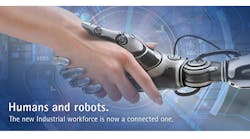A common sight on any manufacturing production floor is the close collaboration relationship between operators and machines. This collaboration is being called the “connected industrial workforce” by Accenture who recently released a study, Machine dreams: Making the Most of the Connected Industrial Workforce.
The robots, called collaborative robots (or cobots) are now designed with the intention of working alongside employees with the goal of assisting in a variety of tasks.
Accenture’s take on this work arrangement is that “by enabling humans to collaborate with machines, in a real-time, two-way exchange, this connected industrial workforce promises to boost manufacturing productivity significantly, as well as improving operational efficiency, and enhancing safety and risk management.”
This view is supported by survey respondents, across the globe, who said they might invest up to one-quarter of their R&D expenditures over the next five years for the technology that will enable this connected workforce.
Looking toward the future, 85% of executive felt the connected workforce would be commonplace in their plants by 2020 and 50% felt that this will lead to higher productivity.
“Cobots are able to take over the mundane and repetitive jobs leaving employees to do the more value-added jobs,” explains many Utpal Bakshi who is managing director - Industrial and Automotive for Accenture. “It’s not a question of workers being replaced as many of these jobs are ones that would be better suited to robots as they are difficult for workers.” He acknowledges that more education is necessary for companies and employees to understand the benefits of this collaborative workforce.
Some industries, such as industrial and automotive, are already ahead of the curve relative to this working arrangement. The study found that currently injection molding is the most commonly assigned task to cobots. And the highest potential is seen in assembling with 39% of companies who plan to assign this task to cobots in the next 5 years. Gluing and welding will be the most common task assigned to cobots with 72% of respondents choosing this function for cobots.
In addition to investment in cobots, companies said they plan to boost investments in other technologies including AR (augmented reality) devices such as smart glasses and helmets.
One example would be Airbus' use of wearable technology to help operators reduce the complexity of assembling cabin seats and decrease the time required to complete the task. Using contextual marking instruction, the smart glasses display all required information for an operator to help mark the floor faster and reduce errors to zero. In addition, the eyewear technology also offers interactivity by granting the professional access to features including barcode scanning, data retrieval from the cloud, voice command and augmented reality.
While adoption of these technologies is strong in some industries, overall only 22% of respondents have actually implemented measures designed to realize the potential of the connected workforce. As many as 85% still describe themselves as digital followers or laggards, rather than leaders.
What’s holding them back are technical concerns. Network, data and cloud security worries loom large; and more than two thirds consider a shortage of skilled human workers to be a high or medium risk—far outweighing employment law or labor union objections, the study points out.
Bakshi says that there are specific actions that can help companies start moving ahead to take advantage of the benefits of the connected workforce.
1) Recognize that human machine interaction gives businesses a competitive edge as it can provide better visibility into manufacturing processes which will result in increased productivity and efficiency.
2)Define specific benefits that apply to your organization. One example is the ability to provide predictive insights into when a machine might breakdown and therefore allow the company to take action and increase machine uptime.
3) The company should determine what internal systems changes will be necessary. For example the IT infrastructure might need to be updated. The company should also examine what cultural changes might be necessary to ensure easy implementation.
4) Companies need to have a longer horizon when it comes to funding these types of improvements.
5) Leadership needs to buy into this concept and make sure that the right structure is in place to manage these changes. For example some companies have created a separate digital factory group or person responsible for moving this structure forward.
Bakshi sees not only a bright future for this type of workforce but he feels it has re-energized the manufacturing sector.
“What is interesting with digital coming into manufacturing is that the next generation of technical companies are suddenly supporting this structure as adding value,” Bakshi noted. “Historially, companies such as Google weren’t paying attention to the manufacturing side. Now with AR further strengthening the connected workforce, there is a lot of innovation coming from the tech sector. And of course that attracts even more people to manufacturing."



